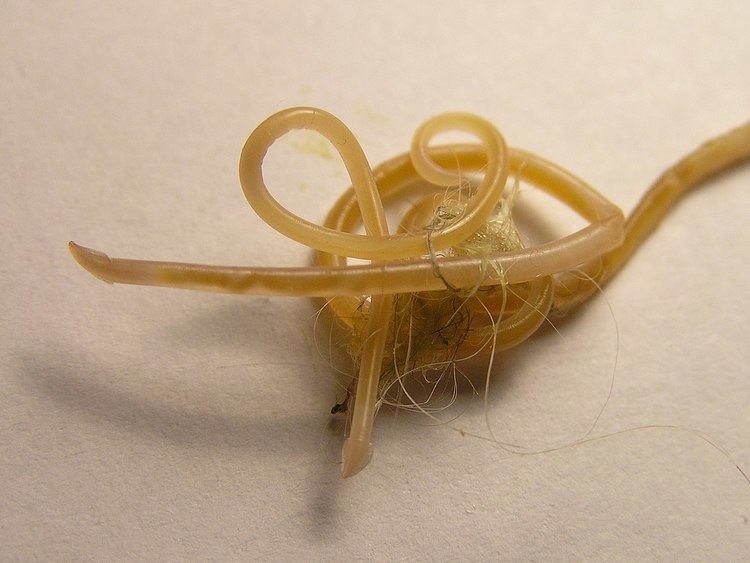Order Ascaridida Genus Toxocara Higher classification Toxocara | Phylum Nematoda Scientific name Toxocara cati Rank Species | |
 | ||
Similar Toxascaris leonina, Roundworms, Ancylostoma tubaeforme, Toxascaris, Dipylidium caninum | ||
Toxocara cati
Toxocara cati (toxo=arrow + cara=head; synonym Toxocara mystax, common name feline roundworm) is worldwide distributed parasite of cats and other felids and it is one of the most common nematodes of cats. This parasite is dangerous as it can infect both wild felids as well as domestic felids. Adult worms are localised in the gut of the host. In adult cats, the infection – which is called toxocariasis – is usually asymptomatic. However, massive infection in juvenile cats can be fatal.
Contents
Feline roundworms may be brownish-yellow to cream colored to pink and may be up to 10 cm in length. Adults have short, wide cervical alae giving their anterior ends the distinct appearance of an arrow (hence their name). Eggs are pitted ovals with a width of 65 μm and a length of about 75 μm making them invisible to the human eye. The larvae are so small that they are easily transmitted from an adult female to her nursing kittens through her milk.
Toxocara cati ciclo de vida
Contact
Contact with the roundworm species for wild felids can come from a variety of sources. The primary source of contact with this species is contact with infected fecal matter. The eggs of the roundworm become infective in three to four weeks after being passed out in fecal matter (Webmd.com 2008). Contact with the soil, licking fur near feet, and eating a host animal (such as rodents) can also lead to infection of the felines (Webmd.com 2008). The consumption of infected carrion also leads to contraction of the parasites, which is some of the food that members of Felidae consume (Umich.edu 2013). The eggs hatch in the intestines and the larvae are then released into the cat’s digestive tract (Web.md.com 2008). The larvae are capable of migrating through the tissues of the wild feline (Web.md.com 2008). The larvae use the blood of the feline to lungs (Web.md.com 2008). From there, they move up to the trachea where they are swallowed causing hacking and other problems (Web.md.com 2008). The larvae can also move throughout the body and cause more damage to the infected individuals. The worms can even go into the mother’s milk and infect the young (Web.md.com 2008)
Clinical signs
There are numerous clinical signs when dealing with Feline Roundworm. Some clinical signs that can be detected easily are vomiting, decreased appetite, and poor growth (VCAHospitals.com 2013). Like many diseases, changes in behavior can also attribute as a symptom of any individuals infected with roundworms. The decreased appetite will result in individuals appear scrawny, mangy, and sickly. The poor growth and decreased appetite is exceptionally detrimental to kittens, as the appetite loss and poor growth will ultimately lead to mortality since this time of growth for kittens is very important. The mortality of kittens will lead to continual decrease of the population as there will be fewer kittens to replace adult mortality. Additional clinical signs that can be identified at closer examination include pot bellied appearance, abdominal discomfort, and diarrhea (VCAHospitals.com 2013). Those with a small number of worms, however, may not show the clinical signs of being infected with worms (VCAHospitals.com 2013) resulting in it being hard to determine if individuals have roundworms.
Detection
Unfortunately, little research has been done as far as identifying the roundworm in wild felid populations. There are some detection methods that have been used in order to help identify roundworm infestation. Possible detection methods for discovering feline roundworm include noting changes in behavior. The change in behavior can be identified through from eyewitness accounts. As change in behavior can include a lack of fear towards humans, eyewitness accounts can be imperative for identifying round worm. Although, detecting the individuals, never mind the infected ones, may prove to be a challenge. Felids especially are hard to detect for roundworm as they are naturally loners by nature (with the exception of the lion, who forms prides) and are cryptic by nature (Umich.edu 2013). Another method to help determine the possibility of roundworm infection is transect studies. The studies implement individuals walking along transects and spotting animals and noting for any unusual behavior within animals of populations. The transect studies, however, need suspicion of infection in order to be implemented. To that end, many DNR (Department of Natural Resources) and other wildlife organizations (such as the US Geological Survey) allow people to provide information regarding suspicion of infection (USGS.gov 2013). These organizations will then have people fill out a sheet detailing the mortality event.
For organizations such as the DNR, reporting individuals that have been viewed (Wi.gov 2013) aids in the detection of individuals infected by roundworm. The contacted DNR will then proceed with the proper procedures to work on dealing with the possibility of roundworm infestation in the area. Many agencies use fecal matter testing and studies to identify the presence of parasites within a population. Agencies take the fecal matter of a suspected population and test the contents for the presence of eggs or remains of adults. Many parasites often pass their eggs through the animal’s fecal matter and as Durant et al. (2012) stated, identification is paramount to reduce the chance of disease or mortality. Soil samples (2012) around the fecal matter are also taken and tested in order to ensure that there is an active roundworm population. Road kill samples also prove to be a way to detect individuals who are infected with roundworm. This is due to animals often acting differently when diseased, as shown from canine distemper, which over time, causes changes in behavior such as losing the fear of humans, becoming unnaturally aggressive, and wandering aimlessly (Tn.gov 2013). These samples can be recovered and then examine for the possibility of roundworm.
